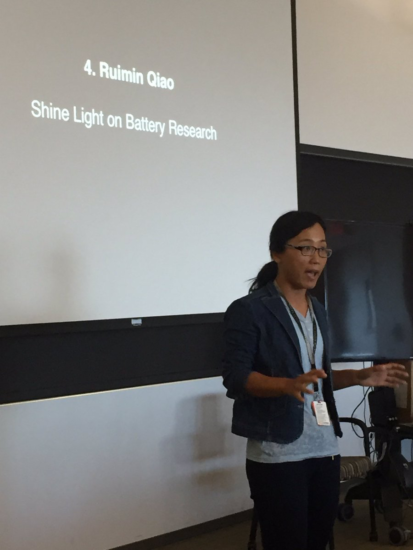 Ruimin Qiao arrived at the ALS in 2010 as a PhD student and is now a postdoctoral researcher working with ALS Staff Scientist Wanli Yang and Jinghua Guo at Beamline 8.0.1. Qiao’s research interests focus on materials for energy applications, primarily batteries. She has published more than 40 papers in peer-reviewed journals, and last month she was selected as the overall winner of the first-ever ALS/Molecular Foundry Science Slam, a joint event between the Berkeley Lab Postdoc Association, the Advanced Light Source, and the Molecular Foundry. Qiao won the slam for her talk “Shining Light on Batteries,” which focused on how synchrotrons can advance battery capabilities.
Ruimin Qiao arrived at the ALS in 2010 as a PhD student and is now a postdoctoral researcher working with ALS Staff Scientist Wanli Yang and Jinghua Guo at Beamline 8.0.1. Qiao’s research interests focus on materials for energy applications, primarily batteries. She has published more than 40 papers in peer-reviewed journals, and last month she was selected as the overall winner of the first-ever ALS/Molecular Foundry Science Slam, a joint event between the Berkeley Lab Postdoc Association, the Advanced Light Source, and the Molecular Foundry. Qiao won the slam for her talk “Shining Light on Batteries,” which focused on how synchrotrons can advance battery capabilities.
We spoke with Qiao about her research and her experience here at the ALS.
What has been your research focus over the past six years at the ALS?
When I first came here, I worked on preparing thin films using all types of processes. My PhD project was on magnetic semiconductors. So I came here to use the tools at the ALS to characterize the materials I’d synthesized. Before I came, I knew little about synchrotrons; I hadn’t ever worked at a synchrotron facility. Once I got here, I was exposed to so many other research topics and learned a lot about the various techniques. After the first year I was here, our whole group started to focus on battery materials, so I’ve been studying that for five years now. Over the course of my research I’ve uncovered new dimensions of battery materials that have led to advances in how we study batteries and how they’re designed.
What have been some of the most exciting moments in your research career at the ALS?
One time we saw some unusual features in the battery materials we were studying. You know, at the ALS, we collect a lot of data using our fancy tools. The data are always trying to tell us some hidden secrets about the material; however, it’s not always easy to decipher the meaning. In this case, it took us probably six months to finally understand the data, and it further inspired us to come up a new type of battery. That was definitely one of the most exciting moments for me. The daily life of being a researcher is to solve problems, one after another, and there are always new problems waiting. It can be very challenging, but it also creates a lot of excitement, especially after you finally get the good solution. As people often say, the rainbow comes after the storm.
What did you speak about in your winning presentation for the recent Science Slam?
I tried to focus on the underlying principles of my research and make it as accessible as possible. So I started by asking people if they own a phone, then asking what powers their phone. Of course it’s a battery, a lithium ion battery more specifically. Then I ask people what is their biggest headache about their phone, and usually the answer is battery life; everyone wants longer battery life. We all want longer lasting and safer batteries, but it’s not a simple task. I explained the basics of how batteries work and how it would be very helpful to be able to see electron energy levels in different materials so that we can engineer those materials to work better for batteries. In order to see these electron levels, you need special eyes and special light—and that’s what the ALS gives us.
The first lithium ion battery was commercialized in 1991. It took the entire industry 25 years to be able to pack two times the energy in the same size battery.
 What have you enjoyed most about working at the ALS?
What have you enjoyed most about working at the ALS?
I feel so lucky to have ended up here and to have worked with Wanli and Jinghua—they are both such great scientists and great supervisors. I truly feel like they have helped me become a more confident researcher and a better person. I feel like now I can pass down that confidence, working with students myself.
I love the people here at the ALS. I feel like here we have such a good culture of collaboration. And I love the weather in Berkeley and all outdoor activities—swimming, running, hiking, camping, backpacking.